
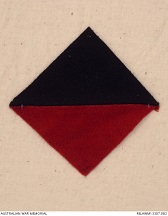
The 21st Battalion Color Patch in WW1
A number of militia-style units existed across Victoria before World War 1.
The Geelong Rifle Corp, formed in 1855 (Source: Geelong Advertiser and Intelligencer 23 April 1855) and also known as the 'Geelong unit', maintained volunteer and militia garrison artillery units, two companies of senior cadets, four companies of school cadets, and a squadron of Light Horse. (Source: The Australasian (Melbourne, Vic. : 1864 - 1946) 26 April 1941)
The Victorian Rifle Volunteers was formed by country rifle club members in 1888 and at first consisted of only three companies. 'A' Company consisted of detachments from rifle clubs at Rupanyup, Lubeck, Stawell, Great Western and Ararat. 'B' Company consisted of detachments from rifle clubs at Charlton, Inglewood, Dunolly and Donald. 'C' Company was formed from rifle clubs at Sheep Hills, Horsham, Warracknabeal and Minyip.
A year later, in 1889 the Victorian Rifle Volunteers were renamed the Victorian Rangers. For a short time, the Corps was commanded by Lieut-Col Tom Price (Dublin Fusiliers) (in addition to his command of the Victorian Mounted Rifles) followed by Colonel Alfred Emanuel 'Teddy' Otter (also known as 'Battle Axe') (Royal Marines) in April 1889. Otter had earlier experience in the Royal Navy, and at the time of his appointment was a Captain in the Permanent Artillery at Queenscliff. He later led the 5th Victorian Mounted Rifles in the Boer War.
By the early 1890s, the Victorian Rangers was made up of three battalions:
In July 1890, The Rangers gained an artillery battery at Hastings for the defence of Westernport. The battery consisted of 40-pounders on travelling carriages, which could be drawn by bullocks.
After 1902, the Victorian Rangers was reorganised forming squadrons of the 9th and 10th Light Horse Regiments. But detachments from Stawell, St Arnaud, Murtoa, Ararat, Inglewood, Cheltenham, and part of the Swan Hill and Lake Boga sections were organised into an infantry unit, retaining the name Victorian Rangers. In 1908, the Victorian Rangers became the 1st Battalion, Victorian Rangers. (Source: Peacock, R. K.:`The Victorian Rangers', in the Victorian Historical Magazine, Vol. XVII, No. 1, May 1938)
In 1911, the Geelong unit was reformed as the 70th Infantry Regiment with headquarters at Ballarat. (Source: The Australasian (Melbourne, Vic. : 1864 - 1946) 26 April 1941)
Compulsory military training was instituted in 1911 for all boys born in 1894, unless they had been given an exemption. AWM Website'100 years since Ballarat answered the call', retrieved 30 June 2019
In 1912, one company of the 1st Battalion, Victorian Rangers was established as the 46th Infantry Regiment. A year later (1913) two and a half companies of the 46th formed the 48th Battalion (not to be confused with the the 48th Battalion that was raised in Egypt on 16 March 1916 as part of the 'doubling' of the AIF - https://www.awm.gov.au/collection/U51488/).
War was declared in Australia early on 5th August 1914. Nine days later on 14 August, Lieutenant Colonel William Bolton, the Commander of the 70th Infantry Regiment, formed the 8th Battalion, 2nd Division AIF. The 8th Battalion participated in the second wave of landings at Gallipoli and on return to Egypt in December 1915 was reformed as the 60th Battalion, 15th Brigade, 5th Division and sent to the Western Front. '100 years since Ballarat answered the call', retrieved 30 June 2019
As noted above, the Geelong unit became the 70th Infantry Regiment, with headquarters at Ballarat. The Ballarat Star carried an article on the 70th Infantry Regiment on 1 February 1915:
70th INFANTRY REGIMENT. PRESENTATION OF COLORS. CEREMONY AT THE EASTERN OVAL.
A picturesque ceremony was the presentation of colors to the 70th Infantry (Ballarat) Regiment which was performed at the Eastern Oval on Saturday afternoon, under, a warm sun, and in the presence of a large crowd of interested spectators. The regimental colors were the gift of the Misses Greenfield, daughters of Lieut.-Colonel Greenfield, a former C-O. of the regiment, whilst the King's colors were donated to the Regiment by the Town Council and Mayor Pearce. The colors are artistically designed, and will, no doubt, prove a decided addition to the regiment. Despite the fact that many members had to travel long distances, there were a good muster of officers and men of the regiment, under Major J. S. Lazarus, officer commanding, who was supported by Adjutant-Lieutenant E. Brind. Majors Dudley and Edgar, former officers of tho regiment in Ballarat, and still associated with it and commanding officers of the Geelong companies, were amongst the visitors present. Captain Tucker was in attendance as the representative of the Brigadier. Colonel It. Lintoii, whilst Colonel G. F. Morton and Lieutenant D. Barnes represented the 71st City of Ballarat Regiment. Colonel Williams (hon, colonel of the 71st) was also present. There was a good attendance of councillors and representative citizens, both of the Town and City, amongst them being the Rev John Walker.
At the outset the Regimental Band, under the conductorship of Bandmaster . Code, played a selection of martial music. The Regiment having been inspected, formed up, the ceremony of consecration of the colors was impressively performed by the Rev. Canon Oolebrook. Mayor Pearce, in handing over the King's colors, said the ceremony performed that day was the outcome of a strong desire that had for a long time existed amongst the ratepayers of the town, that the local 70th Regiment should, have, in common with other Australian regiments, the honor of possessing the King's and Regimental colors. He asked the regiment to look upon the gift as symbolical of the true pride and kindly interest which the people of Ballarat East felt in their boys in the 70th Regiment. The King's colors, which he had the honor to present, had been procured by the council of the town, in conjunction with himself as mayor. He would like the members of the regiment, the colors would be the representing the people in that matter. There was thus a connection of sentiment between the regiment and the fathers and mothers and relatives of the members. From the point of view of th regiment the colors would be the symbol of heroic duty, patience an trials, and all that stood for noble patriotism and service for country, and the country's welfare. History revealed to them what tho colors meant to the regiment. They were to be respected and esteemed, never to be sullied, but always regarded as an emblem to inspire the regiment to defend them with honor, and in courage in tho Nation's cause. He hoped the King's colors would ever help them all to keep in mind and to uphold the sentiment expressed in our National Anthem (Applause.)
Colonel Greenfield, who handed over the regimental colors, spoke in an enthusiastic manner of tho old 3rd Battalion and the 7th Regiment, which preceded the 70th Regiment. He expressed the hope that, the present regiment would emulate tho successes of the past, and maintain its high standing and efficiency. He felt sure that if found necessary they would defend the colors to the very last, and never let them go until every man, hail gone. He hoped that under their excellent commanding officer they would continue to succeed, and preserve the honored name which the regiment had won for itself (Applause.)
The colors were received by Lieutenants Ewens and Dunstan, on bended knee, supported by Color-Sergeants F. F. Taylor and Menhennet, who comprised the color party. The regiment then formed into lines and the colors were unfurled. The color party, facing the regiment, received the salute, and returned to the lines whilst the band played God Save the King'. The CO Major Lazarus, on behalf of the regiment, thanked them for that day's performance. Knowing the men who comprised the forces of Ballarat, he knew the colors would never be disgraced. The men who lived to-day, in Ballarat were the offshoots of the finest stock the world had ever produced, for they had already proved themselves equal to their parents. (Applause.)
The regiment then marched past, Captain Tucker receiving tho salute on behalf of the Brigadier. Colonel B. Linton. Subsequently the Regiment, headed by tho CO and the color party, marched to the Town Hall, where tho colors were placoe in the municipal strong room. Here they will be kept when not in use. Assembling before the Town Hall, the Regiment stood to attention, and at the call of the CO, lustily shouted the regimental battle cry. 'For King and Country and the Girls.' The men then dispersed.
The 23rd Battalion AIF was raised in Victoria in March 1915 as the third battalion of the 6th Brigade, 2nd Division. Its motto was 'Nulli Secundus' (Second to None). Its colour patch was a diamond divided horizontally, brown over red. It included many men from Geelong, including from the 70th Infantry Regiment (which continued to exist). The newly formed 23rd Battalion left Australia in March 1915 and received further training in Egypt. The 6th Brigade landed at ANZAC Cove in early September 2015. The 23rd Battalion was soon manning one of the most trying parts of the Anzac front line - Lone Pine. The fighting here was so dangerous and exhausting that battalions were relieved every day. The 23rd manned Lone Pine, alternating with the 24th Battalion, until they left Gallipoli in December 1915.AWN 23rd Australian Infantry Battalion, retrieved 30 June 2019
Casualties were so high during the Gallipoli campaign that reinforcements were needed. These were raised and sent to Egypt on 8 February 1916 on board the HMAT A68 Anchises. They disembarked in Egypt in April 1916, by which time the 23rd Battalion was already in France.
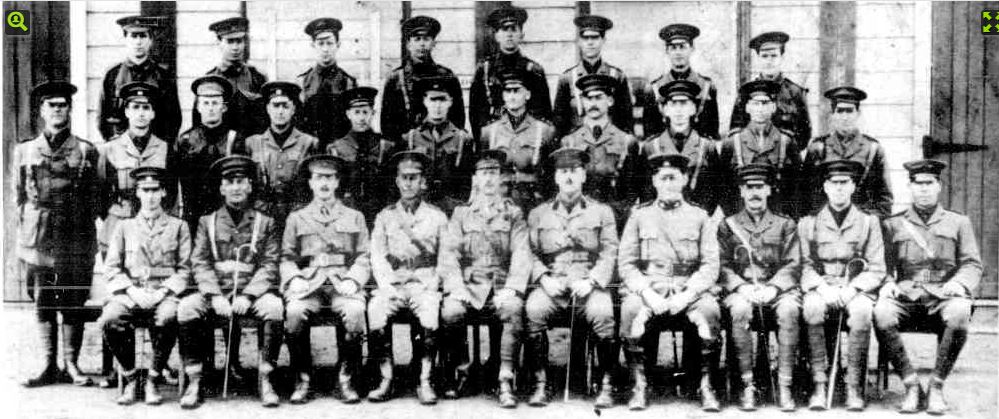
23rd Battalion Officers in 1916 were as follows: (left to right, front row) J.L. Dobson, H.A. Purnell, A.A. Briggs (adjutant), A. Hamilton-Ross, Major J.M. Edgar (C.O.), (name not shown), Major Jana (M.O.), J.W. Thomson, J.H.N. Butt, A.J. Stone, P.F. Cranstoun, E.G. Furnise, W.B. Herbert, C.S. Lorimer, W.O Knott, W.G. Bottoms, L. Withall, G.T. Mousley, W. Doig, W.M. Cook, B.G. Davey. (left to right, back row) W.G. Gray, J.A.W. Keown, (name not shown), C.R. Clutterbuck, W.J. Wodmore, J.L. Harrison, C.A. Blakiston, nd A. Martin. (Source: photograph in The Australasian)
The battalion was next 'in the line' on 10 April 1916, when it occupied forward trenches of the Armentieres sector in northern France. This relatively gentle introduction to the Western Front was followed in July by the horrific battles of Pozieres and Mouquet Farm, after which it was estimated that the Battalion lost almost 90 per cent of its original members.
After manning the front line throughout the bleak winter of 1916-17, the battalion's next trial came at the second battle of Bullecourt in May. After the failure of the first attempt to capture this town, by troops of the 4th Australian Division, this new attack was heavily rehearsed. The 23rd Battalion succeeded in capturing all of its objectives, and holding them until relieved, but, subjected to heavy counter-attacks, the first day of this battle was the battalion's single most costly of the war. Later in 1917 the battalion moved with the rest of the AIF to the Ypres sector in Belgium, and in October participated in the battle to secure Broodseinde Ridge.
In April 1918 the 23rd helped to turn back the German spring offensive, and then took part in the battles that would mark the beginning of Germany's defeat - Hamel, Amiens and Mont St Quentin. The fighting for Mont St Quentin resulted in the battalion's only Victoria Cross, awarded to Private Robert Mactier.
Private Mactier received the V.C. posthumously for conspicuous bravery and devotion to duty on September 1, 1918, when the 23rd Battalion was taking part in the attack on Mont St. Quentin. Singlehanded he captured three strong enemy machine-gun posts, stopped enfilading fire, and enabled the battalion to advance successfully. He was killed by another machine-gun at close range.
The battalion fought its last battle around the town of Beaurevoir between 3 and 4 October 1918. It left the front for the last time on the night of 5 October, and was resting when the armistice was declared on 11 November. The 23rd Battalion disbanded in Belgium on 30 April 1919.
Source - Australian War Memorial (see below)
The Battalion's colour patch was a diamond, top half black and bottom red.

The 21st Battalion Color Patch in WW1
The 21st Battalion, part of the 6th Brigade, was raised at Broadmeadows in Victoria in February 1915. Its recruits were all volunteers who were said to have hailed from all over the state, and indeed Australia. The later enlistment of these men, and their average age of 29, would seem to indicate a more considered decision to enlist that set them apart from those who did so amidst the heady enthusiasm of late 1914. The Battalion was trained at Broadmeadows and Seymour.
The 21st Battalion arrived in Egypt in June 1915 and undertook additional training. It proceeded to Gallipoli in late August. It was an eventful trip - the battalion's transport, the HMT Southland, was torpedoed near the island of Lemnos and had to be abandoned. The battalion finally landed at ANZAC Cove on 7 September where they mainly undertook defensive duties as the last major Allied offensives had been defeated in August that year. One of the Battalion's 'men' was Private James Martin who was only 14 years and nine months when he was killed in Gallipoli.
After evacuation from Gallipoli in December 1915, the 21st Battalion returned to Egypt via Lemnos and undertook Canal Zone defensive duties and further training. It arrived in France in March 1916. In April, it was the first Australian battalion to commence active operations on the Western Front. During the battle of Pozieres in July 1916 it was engaged mainly on portage (carrying) duties. It suffered its heaviest casualties of the war during the fighting around Mouquet Farm.
In early May 1917, the battalion fought at Bullecourt, and then in October participated in the 3-kilometre advance that captured Broodseinde Ridge, east of Ypres. Like the rest of the AIF the battalion saw out the year recuperating from the trials of the Ypres sector.
After helping to blunt the German spring offensive of April 1918, the 21st battalion participated in the battles that would mark the beginning of Germany's defeat: Hamel, Amiens and Mont St. Quentin. The fighting for Mont St Quentin resulted in the battalion's only Victoria Cross, awarded to Sergeant Albert Lowerson.
Like many Australian battalions, the 21st could barely muster a company after the 1918 offensive. Accordingly, it was ordered to disband and reinforce its sister battalions. In response, the men of the 21st mutinied on 25 September 1918. By the end of that day, the order was withdrawn, and the battalion fought its last battle at Montbrehain on 5 October. The following day it became the last Australian battalion to withdraw from active operations on the Western Front. The 21st Battalion was disbanded on 13 October 1918 and its personnel dispersed to other units as reinforcements.
An article in The Age (Melbourne) titled 'Citizen Force Training Camps Start Today' provided some background into the activities of the citizen military forces in Victoria at that time, including the 70th Regiment (Ballarat) and the 69th Regiment (Geelong):
Although the possibility of compulsory military training lies to a great extent overshadowed, the work of the citizen forces in Victoria, the preparations that are being made by the military authorities to accommodate and instruct fresh batches of fighting men are not to be allowed to interfere with the training of the militia units. The trainees of the citizen forces have had a comparatively idle time since 1st July, 1915. There have been no compulsory drills for more than a year, but training will be actively resumed to-day. Camps have been established in various parts of the State, and each citizen soldier will be required to spend at least sixteen days under canvas. The instruction will be continuous, and the men will be required to take there work seriously. Strict regulations have been adopted by the authorities in regard to the conduct of the various camps, and soldiers will not be allowed leave without written authority. The principal training camp will bo at Altona, a few miles outside Williamstown. The site is now ready for occupation, and the first troops will move into the camp to-day. These will comprise the 47th and 48th Infantry, Melbourne University Rifles, 12th A.A.M.C., and. 12th A.A.S.C. Members of the 46th Infantry Regiment also commence their training to-day at the Domain camp. A complete list of the camps to be field during the next four months is as follows:
Partial list below
1st to 14th September.-12th Infantry Brigade. Headquarters, 47th and 48th Regts., Melbourne Univ. Rifles, 12th A.A.S.C., 12th A.A.M.C., at Altona. Commandant, Lieut-Col. K. A. Foxall. Domain Camp.— 46th Infantry. 9th September to 19th September. — 69th Infantry Battalion, 49th A.M.C., at Geelong. Commandant, Major J. M. Edgar.
30th October to 18th November.— 66th Infantry Regiment, at Castlemaine. Commandant, Lieut, Col J. EL Lang. 70th Infantry Regiment, at Ballarat. Commandant, Lieut, -Col. W. K. Bolton. 72nd Infantry Battalion and 40th Battery A.F.A at Warrnambool Commandant, Major P. T. Saner.
As noted already both the 23rd and 21st AIF Battalions were disbanded at the end of World War 1.
In 1918 the 70th Infantry Regiment was designated the 2nd Battalion, 23rd Infantry Regiment, 'to perpetuate traditions and records of A.I.F. battalions'. The 48th Battalion became the 2nd/24th Infantry Regiment.
By 1920, many former soldiers joined the Citizen Military Forces on a part-time basis and went away on camps every year. Some officers who did not join the Citizens Military Forces were placed on the Reserve of Officers.
In 1921, the 2nd Battalion, 23rd Infantry Regiment was renamed the 23rd Battalion and received the territorial designation of 'City of Geelong Regiment'. The 48th Battalion was renamed the 24th Battalion.
In May 1921, the 21st Battalion, known as the 'Victorian Rangers' was re-raised as a Citizens Force unit drawing personel from currently serving Citizen Forces soldiers and ex-AIF members including from the 23rd and 21st Battalions and the 19th Light Horse. Its headquarters was in Warrnambool. The Battalion was assigned to the 6th Brigade (again) but the brigade was allocated to the 4th Division, within the 3rd Military District.
In 1927, when territorial designations were adopted, the 21st Battalion assumed the title of 'Victorian Rangers'. The 21st Battalion's motto 'Pro Deo et Patria (For God and Country), was approved that year.
The compulsory training scheme was abolished in 1929 by the newly elected Scullin Labor government. Combined with the economic privations of the Great Depression the number of recruits available was significantly reduced. Consequently, a decision was made to amalgamate a number of units.
The Geelong Garrison Artillery was disbanded by 1929. As a result of the economic depression and the dwindling number of voluntary recruits after compulsory training ceased, the 23rd (Geelong Regiment) and 21st (Victorian Rangers) Battalions were merged in 1929 to become the 23rd/21st Battalion, known commonly as the City of Geelong Regiment or the Victorian Rangers. (Sources: Grey 2008, p. 138; Keogh 1965, p. 44)
John Charles Robertson was made Officer Commanding, A Company, in the 23rd/21st Battalion by 1934; he was promoted to Major on 3 April 1935. Robertson and his wife Dorothy (known as 'Dorrie' or 'Dot') attended several military balls from the mid-1930s. (Source: Geelong Advertiser, 31 July 1935)
From 1935 the combined 23rd/21st Battalion had an alliance with the Royal Scots Fusiliers ('Tim Earl of Mar's Greybreeks') raised in 1678, the oldest fusiliers regiment, and the second oldest Scottish regiment.
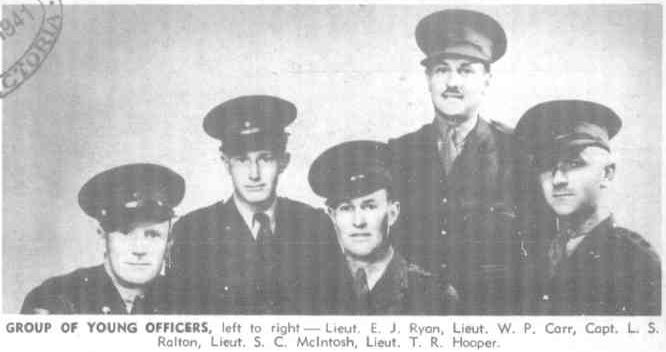
GROUP OF YOUNG OFFICERS, left to right—Lieut. E. J. Ryan, Lieut. W. P. Carr, Capt. L. S. Ralton, Lieut. S. C. Mcintosh, Lieut. T. R. Hooper.
War was declared on Germany on 3 September 1939. At this stage, John Charles Robertson was second in command of the composite 23rd/21st Battalion. Lieutenant-Colonel Arthur Harry Langham Godfrey, D.S.O., M.C., E.D., the 23rd/21st Battalion’s Commanding Officer was seconded to the A.I.F. on 13 October 1939 and given command of the 2/6th Battalion which embarked for the Middle East in April 1940.
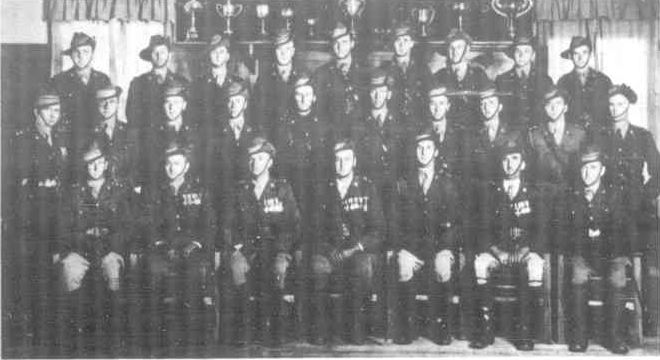
CITY OF GEELONG REGIMENT OFFICERS, at the outbreak of war, left to right, front row — Capt. J. G. Rowan, Major C. A, Ruffin, Major J. C. Robertson, M.C., V.D. (second in command)., Lieut.-Colonel A. H. L. Godfrey, M.C., E.D. (commanding 23rd/21st Battalion), Capt. J. C. W. O'Connor (adjutant), Major K. C. Pumell, M.C., E.D., Capt. L. G. Hamilton. Centre — Lieut. R. W. A. McKenzie, Lieut. R. M. Ford, Lieut. J. G. V. Hudson, Lieut. J. T. McCallum, Lieut. M. * R. McLeod, Lieut. E. W. Stinchcombe, Capt. A. P. Shrimpton, Lieut.. A.. B. Summer, Lieut. F. J. Hurley, Capt. H. A. Dean. Back Row — Lieut. W. S. Whineray, Lieut. R. G. Webb, Capt. E. W. Bryceson, Lieut. K. A. Carroll, Capt. G. F. Smith, Lieut. N. McK. Roddick, Lieut. J. H. Newstead, Lieut. St. E. D. Nelson, Lieut. I. E. Kerr. (Ranks, positions, and decorations given are those held when the picture was taken.)
Photograph to be added - PLANNING A CAMP ROUTE MARCH. left to right—W.O. (second) L. F. C. Bernard; Regimental Sergeant-Major E. P. Thomas; W.O. (first) F. H. Power, regimental quartermaster-sergeant; and Lieut. A. W. Pickett, adjutant and quartermaster.
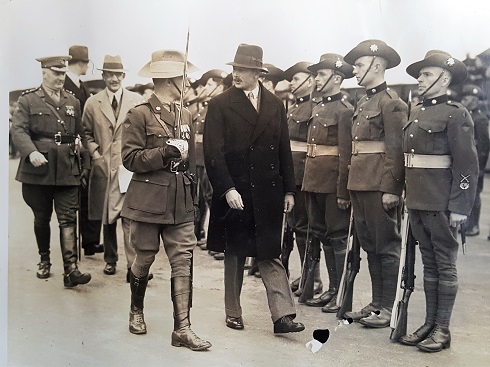
TROOPING THE COLOURS: 23rd/21st Battalion during the Geelong centenary celebrations.
On 22 May 1940, after the 6th and 7th Divisions were complete, the Australian War Cabinet authorised the formation of an 8th Division. On 1 August 1940, Major-General Sturdee took command of the new 8th Division, including the 22nd, 23rd and 24th Infantry Brigades.
The 23/21 Infantry Battalion recorded its Routine Orders from May to June 1940 (Source AWM 8/3/61). These orders, authorised by Lt Col JC Robertson, MC, VC, Commanding Officer, provide an insight into the activities of the Battalion during that period and various names of the men, listed below.
The Orders of 10 April 1940 noted that applications for all ranks for enlistment in the the AIF were to be made by that date. The Battalion was at Mt Martha during this period.
A special parade commemorating Anzac Day was held on 25 April 1940 at the camp. Maj Gen JL Whitham, GOC 4th Division, addressed the men.
As of 4 and 5 June 1940, the strength of the Battalion was stated to be 93 men (which seems too few).
As at 27 May 1940, the Battalion was made up of the following numbers:
Maj Gen Derham, DSO VD, GOC 4th Division, visited the camp on 28 May 1940.
The following names were recorded in the Routine Orders from March to October 1940. VE numbers for other ranks (below Lieut) were not shown until 15 April 1940. An unknown number of the men below enlisted with the AIF during this period. See below for a listing of men recorded in the Routine Orders during 1941.
See below for the list of names from January to December 1941.
John Charles Robertson formally enlisted in the 2nd A.I.F. on 29 October 1940. He was appointed to command the newly formed 2/29th Battalion, part of the 27th Brigade. (Source: The Geelong Advertiser, 7 November 1940).
Lt Col Robertson was ordered to build up his new battalion as quickly as possible. Interestingly, he appears to have taken on board none of the officers of the 23rd/21st Battalion, possibly because it was still regarded as a citizen's force. At least two men of the 23rd/21st Battalion listed above enlisted with the AIF and joined the Battalion: VX39069 Robert Lindsay Uren joined the original force; VX39011 Charles Geoffrey Lovett joined as part of reinforcements sent to Singapore.
Lt Col Robertson interviewed officers of the 2/21st and 2/22nd Battalions between 4 and 6 November, and went to Tasmania to interview officers of the 2/40th on 8 November 1940. On 13 November, Major J K Lloyd was appointed 2IC of the Battalion. On the same day, John went to Sydney to 8 Division HQ and were briefed on future training. On 16 November they went to see the site at Bonegilla Camp to be occupied by the unit where it was to be concentrated. Major John Kevin Lloyd was appointed Second in Command (2IC) of the Battalion on 13 November 1940.
The 23rd/21st Routine Orders from 17 January 1941 record that Captain WS Whineray was the acting Commanding Officer. T/Capt JH Newstead is recorded in that position on 17 March 1941, followed by T/Capt GS Ellis from 25 March 1941. Many of the men noted for duties are the same as the list above.
The option to enlist in the AIF was noted in the Routine Orders to take place from 24 February 1941. The men were able to enlist in their uniform.
Captain LS Ralton was acting Commanding Officer of the Battalion on 10 March 1941. The numbers assigned to the men, as listed in the Orders for that day appear to indicate that the men had already enlisted in the AIF - that is, they had V then a 5-digit number.
Major JR Hall was recorded as the Commanding Officer from 3 May 1941 until 16 June 1941 when Major FN Cornish appears to have taken command in an acting position. Major JR Hall returned as CO from 11 July 1941 until September 1941 when he was appointed Lieutenant Colonel.
Routine Orders refer to air raid precautions for the State of Victoria being in place from 22 September 1941.
The following names were recorded in the Routine Orders during 1941, some of which appear to have been promoted during the year. An unknown number of the men below enlisted with the AIF during this period.
During World War II, the 23rd/21st Battalion carried out defensive duties in Victoria before being deployed to Darwin in the Northern Territory in 1942, where it was assigned to the 19th Brigade, 6th Division.
Due to manpower shortages in the Australian economy, the Battalion was disbanded on 28 August 1943 without having been deployed overseas.
War Diaries
Page created 2 June 2019, updated 25 August 2020. Copyright © Andrew Warland, email: andrewwarland(at)gmail.com